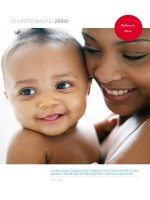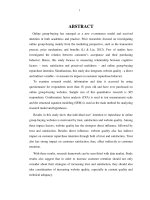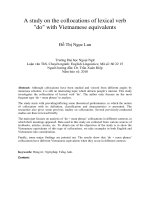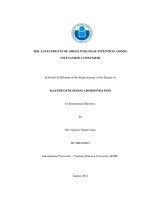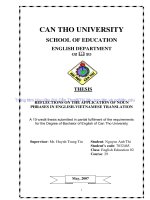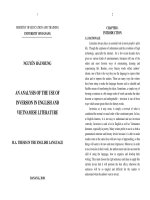The antecedents of green purchase intention among vietnamese consumers
Bạn đang xem bản rút gọn của tài liệu. Xem và tải ngay bản đầy đủ của tài liệu tại đây (1.72 MB, 105 trang )
Header 2.5cm
6.5cm
THE ANTECEDENTS OF GREEN PURCHASE INTENTION AMONG
VIETNAMESE CONSUMERS
In Partial Fulfillment of the Requirements of the Degree of
MASTER OF BUSINESS ADMINISTRATION
In International Business
By
Mr: Nguyen Thanh Tuan
ID: MBA06043
International University - Vietnam National University HCMC
August 2014
INTERNATIONAL UNIVERSITY
VIETNAM
SCHOOL OF BUSINESS
SOCIALIST
REPUBLIC
OF
Independence - Freedom - Happiness
ASSURANCE QUALIFIED THESIS
Student’s Name: NGUYEN THANH TUAN
Student ID: MBA06043
Title of Thesis: THE ANTECEDENTS OF GREEN PURCHASE INTENTION
AMONG VIETNAMESE CONSUMERS
Advisor: DR. PHAM HONG HOA
I assure that the content of this thesis has been qualified all requirements for a
research paper and able to participate in the final thesis defense.
Approved by
DR. PHAM HONG HOA
THE ANTECEDENTS OF GREEN PURCHASE INTENTION AMONG
VIETNAMESE CONSUMERS
In Partial Fulfillment of the Requirements of the Degree of
MASTER OF BUSINESS ADMINISTRATION
In International Business
by
Mr: Nguyen Thanh Tuan
ID: MBA06043
International University - Vietnam National University HCMC
August 2014
Under the guidance and approval of the committee, and approved by all its members,
this thesis has been accepted in partial fulfillment of the requirements for the degree.
Approved:
---------------------------------------------Chairperson
--------------------------------------Committee member
---------------------------------------------Committee member
--------------------------------------Committee member
---------------------------------------------Committee member
--------------------------------------Committee member
i
Acknowledgements
I would like to express my deep gratitude to Dr. Pham Hong Hoa, my research
supervisor, for her patient guidance, enthusiastic encouragement and useful critiques
of this research work.
My grateful thanks are also extended to Management of Company Dunlopillo
Vietnam for supporting to keep my progress on schedule by the way they have
arranged working and training activities which were best fit to my research work.
I wish to acknowledge the help provided by my MBA friends, BA friends and
existing peers who took part in data collection procedures, a much important part of
one research.
I would also like to extend my thanks to office staffs of International University of
Ho Chi Minh City for their help in coordinating necessary activities in the MBA
program.
Finally, I wish to thank my parents for their support and encouragement throughout
my study.
ii
Plagiarism Statements
I would like to declare that, apart from the acknowledged references, this
thesis either does not use language, ideas, or other original material from anyone; or
has not been previously submitted to any other educational and research programs or
institutions. I fully understand that any writings in this thesis contradicted to the
above statement will automatically lead to the rejection from the MBA program at
the International University – Vietnam National University Hochiminh City.
iii
Copyright Statement
This copy of the thesis has been supplied on condition that anyone who
consults it is understood to recognize that its copyright rests with its author and that
no quotation from the thesis and no information derived from it may be published
without the author‟s prior consent.
© Nguyen Thanh Tuan/ MBA06043/2014
iv
Table of Contents
CHAPTER ONE - INTRODUCTION
1.1. RESEARCH BACKGROUND ...........................................................................1
1.2. PROBLEM STATEMENT .................................................................................2
1.3. RESEARCH OBJECTIVES ...............................................................................2
1.4. RESEARCH SCOPE AND LIMITATIONS ......................................................3
1.5. THESIS STRUCTURE .......................................................................................3
CHAPTER TWO – LITERATURE REVIEW
2.1. GREEN MARKETING ......................................................................................5
2.2. GREEN PRODUCT ............................................................................................5
2.3. GREEN PURCHASE INTENTION ...................................................................7
2.4. CONCEPTUAL FRAMEWORK .......................................................................8
2.5. HYPOTHESES DEVELOPMENT .....................................................................13
2.5.1. Environmental Concern ...................................................................................13
2.5.2. Social influences ..............................................................................................14
2.5.3. Willingness to pay ............................................................................................14
2.5.4. Green Corporate Image ....................................................................................15
2.5.5. Packaging .........................................................................................................16
2.5.6. Labels ...............................................................................................................16
2.5.7. Availability.......................................................................................................17
CHAPTER THREE – METHODOLOGY
3.1. LOCATION OF THE STUDY ...........................................................................18
3.2. SAMPLING TECHNIQUES ..............................................................................19
v
3.3. DATA COLLECTION METHOD .....................................................................21
3.4. MEASURES .......................................................................................................22
3.5. DATA ANALYSIS PLAN .................................................................................27
CHAPTER FOUR – FINDINGS AND DISCUSSIONS
4.1. SCREENING DATA ..........................................................................................28
4.2. DESCRIPTIVE STATISTICS ............................................................................30
4.3. RELIABILITY STATISTICS .............................................................................36
4.4. FACTOR ANALYSIS ........................................................................................37
4.4.1. Assumptions .....................................................................................................37
4.4.2. Factor Analysis of Dependent Variable ...........................................................37
4.4.3. Factor Analysis of Independent Variable .........................................................39
4.5. REVISED RESEARCH MODEL .......................................................................44
4.6. ASSESSING NORMALITY AFTER FACTOR ANALYSIS ...........................45
4.7. STANDARD MULTIPLE REGRESSION .......................................................48
4.8. MULTIPLE REGRESSION WITH TRANSFOMRED VARIABLES ..............54
4.9. ONE-WAY BETWEEN GROUPS ANOVA .....................................................55
4.9.1. Test of homogeneity of variances ....................................................................56
4.9.2. One-way ANOVA Test ....................................................................................56
CHAPTER FIVE – CONCLUSIONS AND RECOMMENDATIONS
5.1. MAIN FINDINGS ..............................................................................................59
5.2. RECOMMENDATIONS ....................................................................................62
5.3. CONCLUSIONS .................................................................................................65
vi
References .................................................................................................................66
Appendix A: English Questionnaire .......................................................................71
Appendix B: Vietnamese Questionnaire ................................................................76
Appendix C: Graphs of frequency distribution ....................................................81
vii
List of Tables
Table 1 Summary of previous studies .......................................................................9
Table 2: Measurement Scale Development................................................................24
Table 3: Summary of Categorical Variables ..............................................................28
Table 4: Summary of Continuous Variables ..............................................................29
Table 5: Frequency Distribution of Consumer Location ...........................................31
Table 6: Frequency Distribution of Consumer Gender ..............................................31
Table 7: Frequency Distribution of Consumer Age ...................................................32
Table 8: Frequency Distribution of Consumer Marital Status ...................................32
Table 9: Frequency Distribution of Consumer Education .........................................33
Table 10: Frequency Distribution of Consumer Monthly Income .............................33
Table 11: Frequency Distribution of Consumer Occupation .....................................34
Table 12: Reason why people bought green products ...............................................34
Table 13: Reason why people have not bought green products .................................35
Table 14: Some common green products among respondents ...................................36
Table 15: Reliability Statistics ...................................................................................37
Table 16: KMO and Bartlett's Test of Dependent Variable .......................................38
Table 17: Component Matrix of Dependent Variable................................................38
Table 18: KMO and Bartlett's Test of Independent Variables ...................................39
Table 19: Rotated Component Matrix of Independent Variables ..............................39
Table 20: New Six Independent Variables.................................................................43
Table 21: Correlation Testing of Variables ................................................................48
Table 22: Collinearity Diagnostics ............................................................................49
Table 23: Extreme value of Mahalanobis Distance ...................................................50
Table 24: Casewise Diagnostics ................................................................................51
viii
Table 25: Model Summary.........................................................................................51
Table 26: ANOVA analysis in Multiple Regression..................................................52
Table 27: Coefficients in Multiple Regression ..........................................................53
Table 28: Results of Hypotheses Testing ...................................................................53
Table 29: Results of Transformation..........................................................................54
Table 30: Model Summary after transformation ........................................................55
Table 31: Levene‟s Test in one-way between groups ANOVA ................................56
Table 32: Welch and Brown-Forsythe Test of Occupation Variable .........................56
Table 33: ANOVA Significant values for independent variables ..............................57
Table 34: Multiple comparisons of Occupation Variable ..........................................57
Table 35: ANOVA result of Occupation Variable .....................................................58
ix
List of Figures
Figure 1: Characteristics of green products ..............................................................6
Figure 2: Conceptual Model of Clare D‟Souza et al. (2006) .....................................8
Figure 3: Conceptual Framework of Research ..........................................................13
Figure 4: Revised Research Model ............................................................................45
Figure 5: Normal Distribution Plot of Continuous Variables ....................................46
Figure 6: Normal Q-Q Plot of Environmental Awareness and Labelling ..................47
Figure 7: Plotting Regression Standardized Residual of Dependent Variable ..........50
Figure 8: Final Research Model .................................................................................54
x
Abstract
The rising environmental issues have been contributing to a huge increase in
the number of consumers practicing green purchase, and Vietnam is not exception
for this trend. The study was conducted from February to August 2014 with purpose
of identifying the influence factors of green purchase intention among Vietnamese
consumers, particularly in Ho Chi Minh City. Using convenience sampling
technique, slightly more than 300 surveys were conducted through both online and
direct collecting methods. Then the data was analyzed using test of reliability, factor
analysis, one-way between group analysis of variance and multiple regression. Based
on the results, it can be concluded that the three predictors Willingness to pay, Social
influence and Packaging were significantly impact green purchase intention with
positive direction; and there was a slight difference in green purchase intention
scores for subgroups of Occupation predictor. Although the major drawback of this
research is not investigating green purchase intention on a specific product, it was
one of the few which examined green purchase practice in Vietnam, and on the basis
of the promising findings presented in this research, future studies of the same issue
would be of interest.
Keywords: green product, green purchase intention, green consumers.
xi
This page is intentionally left blank
1
CHAPTER ONE - INTRODUCTION
This chapter presents research background, problem statement, research
objectives, research scope and limitations as well as thesis structure.
1.1 RESEARCH BACKGROUND
Both consumers and manufacturers have recently put higher priority on green
consumption practices in global scale. There have been more attention toward green
products that are assumed to be green or environmentally friendly like “low power
consuming (energy-efficient) electrical appliances, organic foods, lead free paints,
recyclable paper, and phosphate free detergents” (Bhatia and Jain, 2013, p.1). The
reason for this concern could be the fact that our environment is endangered in a
number of ways including global warming, ozone depletion, drinking water shortage,
land degradation, pollution, waste disposal and other causes. Thus implementing
green marketing strategy will assist corporations to meet consumer expectations and
gain more competitive advantages. However, Green Product is a relatively new
concept in Vietnam whereas in the world, consumers tend to buy products with
environmentally friendly benefits. Equally important, it must also be noted that all of
us at least have done something for green living trends in Vietnam in different ways.
In detail, the deputy head of Ho Chi Minh City's Environmental Protection Agency,
Ha Van Dung, has encouraged firms to produce green products to contribute to a
greener environment (Nguyen, 2011). From 2010, numerous green consumption
campaigns or relevant projects have been launched to promote green consumption in
Vietnam, namely “Green Talk” project, “Using environmentally friendly bags”
campaign or “Coopmart Green consumption” campaign. Some Vietnamese
companies now have recently started marketing themselves as green organizations by
following certain government regulations and preferences of worldwide consumers.
2
For instance, Vinamilk has been using FSC packaging which is made from trees,
carefully managed, sustainable and renewable (Nguyen, 2010) or Tide detergent
(P&G Corp), compact bulbs and fluorescent lamps (Dien Quang Lamp Joint Stock
Company) successfully applied "Vietnam Green Label" Programme of the Global
Ecolabelling Network (Nguyen, 2010). Nevertheless, it is argued that number of
businesses involved are relatively small and they are often large organizations in
Vietnam context.
1.2 PROBLEM STATEMENT
Hoang and Nguyen (2012) explored that Vietnamese consumers are little aware
of environmental issues and friendly behave towards the environmental impacts.
However, it is worth noting that there have been very few formal studies with respect
to green marketing or consumers‟ green purchase practice in Vietnam (Hoang and
Nguyen, 2012) and therefore the intention of Vietnamese consumers towards buying
green products is also questionable. To sustain in the competitive business
environment, marketers need to know the factors that persuade consumers to
purchase green products in Vietnam. This also makes it imperative to conduct this
study to identify the factors which have impact on consumer‟s purchase intention
towards green products in order to help companies formulating their green marketing
strategies.
1.3 RESEARCH OBJECTIVES
To build conceptual model of green purchase intention.
To identify the factors that contribute towards consumer‟s green purchase
intention in context of Vietnamese consumers.
To investigate level of influence of each factor on green purchase
intention.
3
To examine the differences between demographic groups in green purchase
intention level.
To understand the issues and challenges of green marketing practices.
1.4 RESEARCH SCOPE AND LIMITATIONS
The research is conducted under constraints of time, geography, human resource,
and financial capacity. Therefore, the scope and limitations of research will be
defined as follows:
The study is only carried out in Ho Chi Minh City with the expected sample
size of approximately 300 green consumers.
One respondent who will be selected might be either a consumer or a buyer.
A consumer is a person who use a product while a buyer is a person who
buy a product for himself (in this case buyer is consumer) or buy a product
for others.
This research will not investigate green purchasing intention on any specific
product category. “Green product” in this study may be any general product
like efficient energy products, health and safe products and so on.
This is a cross-sectional study, so it does not reflect customers‟ intention
overtime. They might not be much aware of green product right now, but
they could be willing pay more to buy green product in the future.
1.5 THESIS STRUCTURE
The thesis includes 5 chapters:
Chapter 1-Introduction: This chapter presents background, statement of
problem, research objectives and research scopes.
4
Chapter 2-Literature Review: This chapter explains basic concepts, previous
studies which were used to set up a new conceptual model as well as develop
hypotheses.
Chapter 3-Methodology: This chapter deals with research procedures including
sample selection, data collection method, and plan of data analysis.
Chapter 4-Findings and Discussions: The chapter covers data processing,
analysis results and variety of discussions.
Chapter 5-Conclusions and Recommendations: The last section serves as an
conclusion including managerial implications for green corporates in Vietnam.
5
CHAPTER TWO – LITERATURE REVIEW
This chapter aims to give a comprehensive account of related concepts and
previous studies that were used as foundation for further analyses in this research.
2.2 GREEN MARKETING
As reported by Bhatia and Jain (2013), “Green marketing” or “Ecological
marketing” or “Environmental marketing” was defined by American Marketing
Association (AMA): “Marketing of products that are presumed to be
environmentally safe is called as green marketing”. It has also been suggested that
green marketing activities can both satisfy the needs of human and to minimize the
controvert influences to natural environment (Azizan and Suki, 2014). There have
been a wide range of activities covered under green marketing concept including
product modification, changes of manufacturing process, environmental packaging
and so on (Bhatia and Jain, 2013). Today, consumers also strongly expressed their
concerns toward environmental impact of products, hence it is essential for
companies to market themselves as green organizations to sustain in competitive
environment. It is also recognized that many companies that now try to pursue green
marketing will absolutely face a great deal of challenges such as unfavorable
consumer perception and high cost of production, and there is a urgent need to
explore green consumers‟ characteristics to help companies to develop a right target
and market segmentation strategies (D'Souza, Taghian, Lamb and Peretiatkos, 2006).
In another research, Boztepe (2012) concluded that green marketing will target not
only making profit in short-term but also for long-term profitability and sustainable
development. It seems green marketing have started becoming agenda of worldwide
enterprises.
2.3 GREEN PRODUCT
6
Consumers now frequently encounter with terms such as “environmentally
friendly”, “eco-friendly” or “green” products in green marketing era. According to
Webster's New Millennium Dictionary of English, all terms “environmentally
friendly”, “eco-friendly”, “nature-friendly”, and “green” are marketing terminologies
describing products which have minimal or no harm on eco-system. Another relevant
point is that the term green product will be mostly used throughout the study to help
readers to follow more easily. Chen and Chai (2010) specified green product as the
product which will not overuse natural resources and recyclable at the same time. To
put it another way, Chen and Chai (2010) also cited a new definition of green
product from research of Elkington and Makower (1998) that green product refers to
a product which has more environmentally sound content or suitable packaging in
cutting down the environmental effect. In other words, D'Souza et al. (2006)
characterized green product based on several features including growing originally,
being reusable or recyclable, and creating by natural ingredients. Furthermore, the
year 2012 witnessed a broader definition of green product from Bhatia and Jain. That
is to say there has been no consensus on what exactly green product be and indicated
some common features which are globally accepted as green in the following figure:
Figure 1: Characteristics of green products
Source: Bhatia and Jain (2013)
7
In 2009, Vietnam Green Label Program of the Global Ecolabelling Network
(GEN) has been launched, considering green product as product which cause less
environmental issues compared to other same type of products from the process of
processing materials, producing, distributing, being used as well as after being
disposed. This understanding also resembles other literatures. In reality, many
enterprises now only take into account profits, and ignore solutions to lessen
pollution and save energy. However, in the long term, companies do need to have
activities to integrate production with environmental protection to increase
competitive advantages as well as enhances the trust of consumers (Nguyen, 2011).
2.4 GREEN PURCHASE INTENTION
Governments, organizations, and businesses have been creating some serious
changes for awakening consumers‟ green purchase habit in a global scale, thus
having many studies conducted to explore consumers‟ green purchase intention over
decades is sense of understandable. Initially, with the term “behavioral intention”,
Mei, Ling and Piew (2012) stated that behavioral intention is a measure of one‟s
relative strength of purpose to have a specific action. In a recent paper by Mei, Ling
and Piew (2012), green purchase intention is a person‟s willingness to give
preference to green product over traditional products. On another point, Paço and
Rosa Reis (2012) conceptualized green purchase intention as a person‟s plan to
perform a green behavior in a specific time. According to many previous studies like
research studies, green purchase intention is critical predictor of green purchase
behavior. In other words, it is claimed that green purchase intention can affect the
probability of a customer decision when that one will buy eco-friendly products.
8
2.5 CONCEPTUAL FRAMEWORK
The conceptual model of this research is associated by some previous relevant
models. The key model is the model developed by D'Souza, Taghian, Lamb and
Peretiatkos (2006), and the study also adopts some critical findings from other
researches. The summary for those previous studies will be presented in Table 1.
D‟Souza et al. (2006) aimed to investigate effect of factors to green purchase
intention of consumers in Australia and explain its implication on corporate strategy.
However, this group of researchers measured the effect of environmental factors on
consumers‟ perception towards green products first, and then continued to measure
the impact of consumer‟ overall perception about green products on green purchase
intention. Environmental factors investigated in that research were corporate
perception, corporate regulatory compliance, product perception, product labels,
packaging, ingredients, and consumers' past experience. The research model of
D‟Souza et al. (2006) will be shown in figure 2.
Figure 2: Conceptual Model of D’Souza et al. (2006)
Source: D‟Souza et al. (2006)
9
Table 1
Summary of previous studies
Sources: D‟Souza et al. (2006), Roberts and Bacon (1997), Boztepe (2012), Mei, Ling and Piew (2012) and Kumar (2012).
Topic
Year
Author
Nation
Findings
Corporate perception, regulatory protection, labels,
1
Green products and corporate strategy:
an empirical investigation
Clare D'Souza, Mehdi
2006
Taghian, Peter Lamb, and
packaging, ingredients negatively influenced
Australia
Roman Peretiatkos
customers' perception formation about green
products while only past experience positively
contributed to customers' perception.
Exploring the subtle relationships between
2
environmental concern and ecologically conscious
James A. Roberts and
1997
Donald R. Bacon
America
consumer behavior
Environmental concern has significant impact on
ecologically conscious consumer behavior.
Environmental awareness, green product features,
3
Green marketing and its impact on consumer
buying behavior
2012
Aysel Boztepe
Turkey
green promotion activities
and green price affect green purchasing
behaviors of the consumers in positive way
4
The Antecedents of Green Purchase Intention
among Malaysian Consumers
2012
Ooi Jen Mei, Kwek Choon
Ling, Tan Hoi Piew
The most powerful antecedent in affecting the
Malaysia
green purchase intention of Malaysian consumers
is government initiative followed by environmental
10
knowledge, peer pressure and environmental
attitude.
Availability of environmentally sustainable products
Theory of planned behaviour approach to
5
understand the purchasing behaviour for
environmentally sustainable products
2012
Bipul Kumar
India
was found to have a positive relation with the
purchase intention for the environmentally
sustainable products.
11
The current study will apply model of D‟Souza et al. (2006) with some factors
impacting directly on green purchase intention without mediating level “consumer
perception”. To be more applicable in context of Vietnam, factors were modified. It is
reported by an analyst of Marketervietnam.vn (2013) that Vietnam currently stay in
initial stage for green consumption practice, and the number of green corporates is
relative small as well as all stakeholders in Vietnam society are putting more efforts to
raise customers‟ awareness of green purchase habit. Due to the above reason,
Vietnamese consumers do not have many past experiences of buying green products as
well as perception of green product. Likewise, environmental regulation system in
Vietnam is still being improved to encourage and protect green corporates. Thus, the
three factors “past experience”, “product perception” and “regulatory protection” would
not be applied in this research. Particularly, factor “ingredients” will not be picked out as
well because the current research aims to investigate green products in general, not only
cosmetics, food and beverage but also energy-efficient electrical appliances, fuelefficient vehicles, recycled papers, etc. Therefore, the rest of three factors, namely
labels, packaging, and corporate perception are selected to investigate their direct impact
on green purchase intention. On another note, “corporate perception” will be adjusted to
be called “green corporate image” factor in current study.
In addition, the study also adopted some findings from other previous literatures.
With the research “Exploring the subtle relationships between environmental concern
and ecologically conscious consumer behavior”, James A. Roberts and Donald R. Bacon
discussed an interesting factor “environmental concern” and its multidimensional impact
on ecologically conscious consumer behavior including green purchase behavior through


